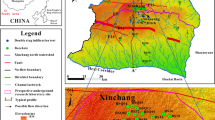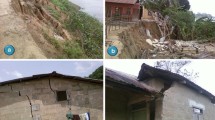Abstract
Characterizing the groundwater flow pattern in a landslide would help to establish a monitor-warning system to predict the movement of a highly concealed and extremely hazard translational landslide. The complex fracture network in this type of landslide affects the rainfall infiltration process and the groundwater flow. In this paper, multi-tracer tests, injection tests and electrical resistivity tomography were used to investigate the hydrogeological characteristics and groundwater dynamics of the Kualiangzi translational rock landslide, which is located in the northeast of the Sichuan Basin, China. The study results indicate that there are two kinds of groundwater flow mode, in the landslide, the concentrated mode and the dispersed mode. Tracer and injection test results indicate that the groundwater flow in the landslide is mainly controlled by a vertical preferential flow pathway (concentrated mode), of which the direction is approximately perpendicular to the sliding direction of the landslide. The main runoff direction in the middle of this landslide is southwest according to electrical resistivity tomography. The hydraulic conductivity in the preferential direction is more than 3750 times larger than that perpendicular to the direction. The groundwater flow along the weathered sandstone and mudstone media in the vicinity of the slip surface is very slow (dispersed mode). The results reveal the existence of a preferential flow pathway. The hydrogeological conceptual model is considered as an unbounded domain with an anisotropic medium in the whole area. This hydrogeological model clearly describes the hydrological conditions, and can help establish a monitor-warning system in a translational landslide.









Similar content being viewed by others
References
Asch TWJV, Hendriks MR, Hessel R, Rappange FE (1996) Hydrological triggering conditions of landslides in varved clays in the French alps. Eng Geol 42:239–251. https://doi.org/10.1016/0013-7952(95)00082-8
Audebert M, Clément R, Moreau S, Duquennoi C, Loisel S, Touze-Foltz N (2016) Understanding leachate flow in municipal solid waste landfills by combining time-lapse ERT and subsurface flow modelling - part I: analysis of infiltration shape on two different waste deposit cells. Waste Manag 55:165–175. https://doi.org/10.1016/j.wasman.2016.04.006
Battaglia D, Birindelli F, Rinaldi M, Vettraino E, Bezzi A (2016) Fluorescent tracer tests for detection of dam leakages: the case of the Bumbuna dam - Sierra Leone. Eng Geol 205:30–39. https://doi.org/10.1016/j.enggeo.2016.02.010
Cassiani G, Bruno V, Villa A, Fusi N, Binley AM (2006) A saline trace test monitored via time-lapse surface electrical resistivity tomography. J Appl Geophys 59:244–259. https://doi.org/10.1016/j.jappgeo.2005.10.007
Chatwin PC (1971) On the interpretation of some longitudinal dispersion experiments. J Fluid Mech 48:689–702. https://doi.org/10.1017/S0022112071001800
Chen RX, Lin M (1999) Groundwater hydraulics. China University of Geosciences Press, Wuhan
Chou TK, Chouteau M, Dube JS (2016) Estimation of saturated hydraulic conductivity during infiltration test with the aid of ERT and level-set method. Vadose Zone J 15. doi:https://doi.org/10.2136/vzj2015.05.0082
Cook R, Barlas N (2014) Aquifer anisotropy in the pen argyl member of the Martinsburg formation, Pennsylvania. Environ Eng Geosci 20:273–285. https://doi.org/10.2113/gseegeosci.20.3.273
Day TJ (1975) Longitudinal dispersion in natural channels. Water Resour Res 11:909–918. https://doi.org/10.1029/WR011i006p00909
Dewandel B, Lachassagne P, Zaidi FK, Chandra S (2011) A conceptual hydrodynamic model of a geological discontinuity in hard rock aquifers: example of a quartz reef in granitic terrain in South India. J Hydrol 405:474–487. https://doi.org/10.1016/j.jhydrol.2011.05.050
Dong H, Chen J, Li X (2016) Delineation of leakage pathways in an earth and rockfill dam using multi-tracer tests. Eng Geol 212:136–145. https://doi.org/10.1016/j.enggeo.2016.08.003
Fan XM (2007) Study on genetic mechanism and control methods of translational gliding landslide. Dissertation, Chengdu University of Technology
Fan XM, Xu Q, Zhang ZY, Meng DS, Tang R (2009) The genetic mechanism of a translational landslide. Bull Eng Geol Environ 68:231–244. https://doi.org/10.1007/s10064-009-0194-1
Fetter CW (1992) Contaminant hydrogeology. Mac Millan Publishing Company, New York
Field MS (2002) The QTRACER2 program for tracer-breakthrough curve analysis for tracer tests in karstic aquifers and other hydrologic systems. National Center for Environmental Assessment--Washington Office, Office of Research and Development, US Environmental Protection Agency, Washington, DC
Hantush MS, Thomas RG (1966) A method for analyzing a drawdown test in anisotropic aquifers. Water Resour Res 2:281–285. https://doi.org/10.1029/WR002i002p00281
Hartmann S, Odling NE, West LJ (2007) A multi-directional tracer test in the fractured chalk aquifer of E. Yorkshire, UK. J Contam Hydrol 94:315–331. https://doi.org/10.1016/j.jconhyd.2007.07.009
Heilweil VM, Hsieh PA (2006) Determining anisotropic transmissivity using a simplified Papadopulos method. Ground Water 44:749–753. https://doi.org/10.1111/j.1745-6584.2006.00210.x
Huang RQ (2012) Mechanisms of large-scale landslides in china. Bull Eng Geol Environ 71:161–170. https://doi.org/10.1007/s10064-011-0403-6
Kern JW, Dobson CW (1998) Determination of variances for maximum and minimum transmissivities of anisotropic aquifers from multiple well pumping test data. Ground Water 36:457–464. https://doi.org/10.1111/j.1745-6584.1998.tb02817.x
Kincaid T, Davies GJ, Werner CL, Dehan R (2012) Demonstrating interconnection between a wastewater application facility and a first magnitude spring in a karstic watershed: tracer study of the southeast farm wastewater reuse facility Tallahassee, Florida. Florida Department of Environmental Protection Florida Geological Survey Report of Investigation No. 111, Florida Geological Survey, Tallahassee, pp 9–10
Krzeminska DM (2012) A conceptual model of the hydrological influence of fissures on landslide activity. Hydrol Earth Syst Sci 16:1561–1576. https://doi.org/10.5194/hess-16-1561-2012
Krzeminska DM, Bogaard TA, Malet JP, Beek LPHV (2013) A model of hydrological and mechanical feedbacks of preferential fissure flow in a slow-moving landslide. Hydrol Earth Syst Sci 17:947–959. https://doi.org/10.5194/hess-17-947-2013
Lee JY, Kim HS, Choi YK, Kim JW, Cheon JY, Yi MJ (2007) Sequential tracer tests for determining water seepage paths in a large rockfill dam, Nakdong River basin, Korea. Eng Geol 89:300–315. https://doi.org/10.1016/j.enggeo.2006.11.003
Ling CP, Xu Q, Zhang Q, Ran JX, Lv HB (2016) Application of electrical resistivity tomography for investigating the internal structure of a translational landslide and characterizing its groundwater circulation (Kualiangzi landslide, Southwest China). J Appl Geophys 131:154–162. https://doi.org/10.1016/j.jappgeo.2016.06.003
Liou TS (2007) Numerical analysis of a short-term tracer experiment in fractured sandstone. Terr Atmos Ocean Sci 18:1029–1050. https://doi.org/10.3319/TAO.2007.18.5.1029(Hy)
Lloyd JBF (1971) Synchronized excitation of fluorescence emission spectra. Nature 231:64–65. https://doi.org/10.1038/physci231064a0
Loke MH (2007) RES2DINV ver.3.56 for Windows 98/Me/2000/NT/XP Rapid 2-D Resistivity & IP inversion using the least-squares method. Geotomo Software, Penang
Loke MH, Barker RD (1996) Rapid least-squares inversion of apparent resistivity pseudosections by a quasi-Newton method. Geophys Prospect 44:131–152. https://doi.org/10.1111/j.1365-2478.1996.tb00142.x
Maloszewski P, Herrmann A, Zuber A (1999) Interpretation of tracer tests performed in fractured rock of the Lange Bramke basin, Germany. Hydrogeol J 7:209–218. https://doi.org/10.1007/s100400050193
Motz LH (2009) Multiple-pumped-well aquifer test to determine the anisotropic properties of a karst limestone aquifer in Pasco County, Florida, USA. Hydrogeol J 17:855–869. https://doi.org/10.1007/s10040-008-0408-9
Nelson RA, Amoco BP, Houston TX (2001) Geologic analysis of naturally fractured reservoirs, second edition. Geologic Analysis of Naturally Fractured Reservoirs, Houston
Neuman SP, Walter GR, Bentley HW, Ward JJ, Gonzalez DD (1984) Determination of horizontal aquifer anisotropy with three wells. Ground Water 22:66–72. https://doi.org/10.1111/j.1745-6584.1984.tb01477.x
Papadopoulos IS (1965) Nonsteady flow to a well in an infinite anisotropic aquifer. In: Proceedings of International Association of Scientific Hydrology, Dubrovnik Symposium on the Hydrology of Fractured Rocks, Paris, September 1965, pp 21–31
Petrella E, Falasca A, Celico F (2008) Natural-gradient tracer experiments in epikarst: a test study in the Acqua dei Faggi experimental site, southern Italy. Geofluids 8:159–166. https://doi.org/10.1111/j.1468-8123.2008.00214.x
Ptak T, Piepenbrink M, Martac E (2004) Tracer tests for the investigation of heterogeneous porous media and stochastic modelling of flow and transport—a review of some recent developments. J Hydrol 294:122–163. https://doi.org/10.1016/j.jhydrol.2004.01.020
Pudasaini SP (2016) A novel description of fluid flow in porous and debris materials. Eng Geol 202:62–73. https://doi.org/10.1016/j.enggeo.2015.12.023
Ronchetti F, Borgatti L, Cervi F, Gorgoni C, Piccinini L, Vincenzi V, Corsini A (2009) Groundwater processes in a complex landslide, northern Apennines, Italy. Nat Hazards Earth Syst Sci 9:895–904. https://doi.org/10.5194/nhess-9-895-2009
Seaman JC, Bertsch PM, Wilson M, Singer J, Majs F, Aburime SA (2007) Tracer migration in a radially divergent flow field: longitudinal dispersivity and anionic tracer retardation. Vadose Zone J 6:373–386. https://doi.org/10.2136/vzj2006.0109
Shao W, Bogaard TA, Bakker M, Greco R (2015) Quantification of the influence of preferential flow on slope stability using a numerical modeling approach. Hydrol Earth Syst Sci 19:2197–2212. https://doi.org/10.5194/hess-19-2197-2015
Spek JEVD, Bogaard TA, Bakker M (2009) Characterization of groundwater dynamics in landslides in varved clays. Hydrol Earth Syst Sci 10:2171–2183. https://doi.org/10.5194/hess-17-2171-2013
Uchida T, Kosugi K, Mizuyama T (2001) Effects of pipeflow on hydrological process and its relation to landslide: a review of pipeflow studies in forested headwater catchments. Hydrol Process 15:2151–2174. https://doi.org/10.1002/hyp.281
Wen JC, Wu CM, Yeh TCJ, Tseng CM (2010) Estimation of effective aquifer hydraulic properties from an aquifer test with multi-well observations (Taiwan). Hydrogeol J 18:1143–1155. https://doi.org/10.1007/s10040-010-0577-1
Xu JG (2006) Fluorescence analysis. Science Publishing House, Beijing
Xu Q, Liu HX, Ran JX, Li WH, Sun X (2016) Field monitoring of groundwater responses to heavy rainfalls and the early warning of the Kualiangzi landslide in Sichuan Basin, southwestern China. Landslides 13:1555–1570. https://doi.org/10.1007/s10346-016-0717-3
Xue YQ, Wu JC (2010) Groundwater hydraulics. Geology Publishing House, Beijing
Zhai GJ (2011) Analysis of the basic characteristics and deformation mechanism of Kualiangzi landslide in Zhongjiang. Dissertation, Chengdu University of Technology
Zhang ZY, Wang ST, Wang LS (1994) The analytical principle in engineering geology. Beijing Geological Publishing House, Beijing
Acknowledgements
This research is supported by the National Basic Research Program (973 Program; grant number 2013CB733200); the Survey Project from the China Geological Survey (grant number 12120113010100). The authors would like to acknowledge the support in field and laboratory work provided by Junqing Wang and other people.
Author information
Authors and Affiliations
Corresponding authors
Rights and permissions
About this article
Cite this article
Lv, H., Ling, C., Hu, B.X. et al. Characterizing groundwater flow in a translational rock landslide of southwestern China. Bull Eng Geol Environ 78, 1989–2007 (2019). https://doi.org/10.1007/s10064-017-1212-3
Received:
Accepted:
Published:
Issue Date:
DOI: https://doi.org/10.1007/s10064-017-1212-3




